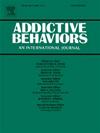抑郁症状和药物使用的月度模式及其与长期有害物质使用和精神健康问题的关系:利用年轻人的月度数据检查相互维持
IF 3.7
2区 医学
Q1 PSYCHOLOGY, CLINICAL
引用次数: 0
摘要
目前的研究调查了在经历更严重抑郁症状的月份中表现出更多物质使用模式的年轻人是否长期使用有害酒精和大麻并加剧抑郁症状。数据来自华盛顿州772名年轻人(平均年龄= 21.1岁,SD = 1.7;57%为女性)。连续24个月,调查询问了过去一个月的抑郁症状、每周饮酒的典型次数和每周吸食大麻的典型时间。参与者在基线后30个月完成了一项调查,其中包括抑郁症状和有害酒精和大麻使用的测量。多层模型显示,在头24个月内,抑郁症状与酒精和大麻使用之间的月度个人内部关联存在很大差异。与平均水平相比,在经历抑郁症状增加的月份,一些年轻人使用更多的酒精或大麻,而另一些则使用较少。当将30个月的随访结果与从多层模型中提取的个人特异性斜率联系起来时,结果表明,当年轻人经历的抑郁症状比平均水平更多时,他们倾向于喝更多的酒或使用更多的大麻,在30个月的随访中,他们分别报告了更高的有害酒精和大麻使用水平。个体特异性坡度与30个月抑郁症状无关。虽然人与人之间的月度关联存在很大差异,但研究结果表明,表现出与增加酒精和大麻使用以调节抑郁症状相一致的短期模式的年轻人可能受益于旨在降低长期使用有问题物质风险的预防和干预努力。本文章由计算机程序翻译,如有差异,请以英文原文为准。
Monthly patterns of depressive symptoms and substance use and their relation to longer-term hazardous substance use and mental health problems: Examining mutual maintenance using monthly data from young adults
The current study examined whether young adults showing a pattern of greater substance use on months when experiencing greater levels of depressive symptoms showed long-term hazardous alcohol and cannabis use and elevated depressive symptoms. Data were from 772 young adults in Washington State (mean age = 21.1 years, SD = 1.7; 57 % female). For 24 consecutive months, surveys asked about past-month depressive symptoms and typical number of alcoholic drinks per week and typical number hours high on cannabis per week. Participants completed a survey 30 months after baseline that included measures of depressive symptoms and hazardous alcohol and cannabis use. Multilevel models showed substantial variability in monthly within-person associations of depressive symptoms with alcohol and cannabis use across individuals during the first 24 months. On months when experiencing increased depressive symptoms compared to their average, some young adults used more alcohol or cannabis and some used less. When linking outcomes at 30-month follow-up to person-specific slopes extracted from the multilevel models, results showed that young adults who tended to drink more or use more cannabis when they experienced more depressive symptoms than their average reported greater levels of hazardous alcohol and cannabis use at 30-month follow-up, respectively. Person-specific slopes were not associated with 30-month depressive symptoms. Although there was substantial variability in within-person monthly associations, findings suggest that young adults showing short-term patterns consistent with increased alcohol and cannabis use to regulate depressive symptoms may benefit from prevention and intervention efforts aimed at decreasing risk of longer-term problematic substance use.
求助全文
通过发布文献求助,成功后即可免费获取论文全文。
去求助
来源期刊

Addictive behaviors
医学-药物滥用
CiteScore
8.40
自引率
4.50%
发文量
283
审稿时长
46 days
期刊介绍:
Addictive Behaviors is an international peer-reviewed journal publishing high quality human research on addictive behaviors and disorders since 1975. The journal accepts submissions of full-length papers and short communications on substance-related addictions such as the abuse of alcohol, drugs and nicotine, and behavioral addictions involving gambling and technology. We primarily publish behavioral and psychosocial research but our articles span the fields of psychology, sociology, psychiatry, epidemiology, social policy, medicine, pharmacology and neuroscience. While theoretical orientations are diverse, the emphasis of the journal is primarily empirical. That is, sound experimental design combined with valid, reliable assessment and evaluation procedures are a requisite for acceptance. However, innovative and empirically oriented case studies that might encourage new lines of inquiry are accepted as well. Studies that clearly contribute to current knowledge of etiology, prevention, social policy or treatment are given priority. Scholarly commentaries on topical issues, systematic reviews, and mini reviews are encouraged. We especially welcome multimedia papers that incorporate video or audio components to better display methodology or findings.
Studies can also be submitted to Addictive Behaviors? companion title, the open access journal Addictive Behaviors Reports, which has a particular interest in ''non-traditional'', innovative and empirically-oriented research such as negative/null data papers, replication studies, case reports on novel treatments, and cross-cultural research.
 求助内容:
求助内容: 应助结果提醒方式:
应助结果提醒方式:


